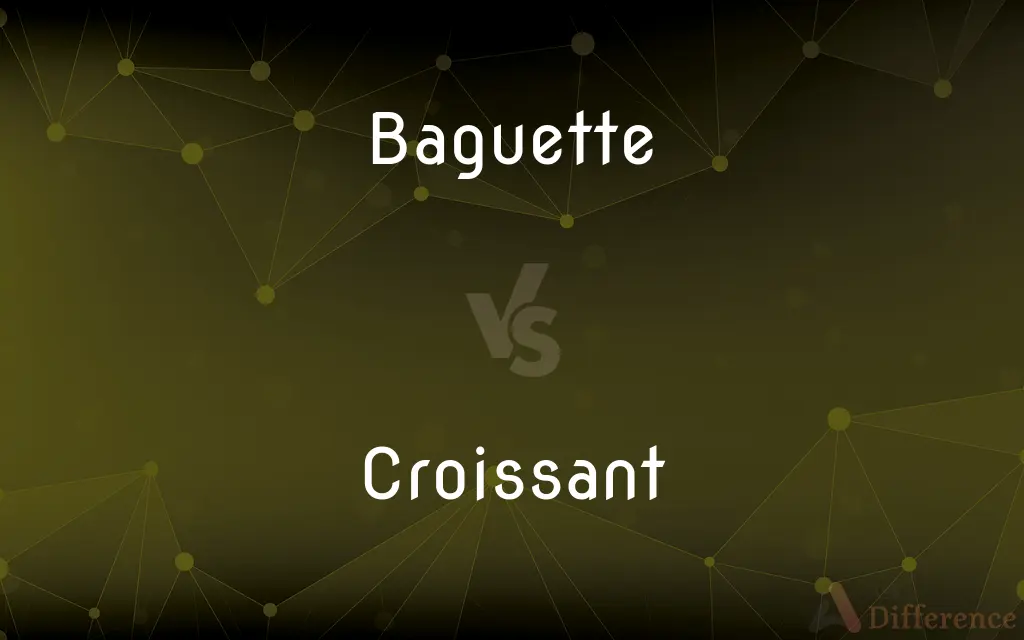Baguette vs. Croissant — What's the Difference?
Edited by Tayyaba Rehman — By Maham Liaqat — Updated on March 11, 2024
A baguette is a long, thin French bread, known for its crusty exterior, while a croissant is a flaky, buttery pastry, shaped like a crescent.

Difference Between Baguette and Croissant
Table of Contents
ADVERTISEMENT
Key Differences
Baguettes, originating from France, are distinguished by their length and slender shape, typically measuring about 26 inches long and 2-3 inches in diameter. Their crust is golden and crisp, with a soft, airy interior. Croissants, also French, are made from a layered yeast-leavened dough, with butter folded into the dough multiple times to create its characteristic flaky layers. The dough is then rolled and shaped into a crescent before baking.
The making of a baguette involves a simple dough of flour, water, yeast, and salt, which is then baked to achieve a crunchy crust and chewy center. Croissants, on the other hand, require a more complex process known as laminating, where butter is continuously folded into the dough to create hundreds of layers, resulting in a rich, buttery flavor and flaky texture.
Baguettes are often used as a staple bread in France, served with meals, used for sandwiches, or enjoyed with butter and cheese. Croissants are typically enjoyed as a breakfast item or snack, often paired with coffee or filled with chocolate, almond paste, or ham and cheese for a more indulgent treat.
While both baguettes and croissants are integral to French cuisine, their textures and flavors are distinct: baguettes are known for their simplicity and versatility, whereas croissants are celebrated for their luxurious, indulgent quality.
Comparison Chart
Origin
France
France
ADVERTISEMENT
Dough Composition
Simple (flour, water, yeast, salt)
Layered with butter (flour, water, yeast, butter)
Texture
Crusty exterior, soft interior
Flaky, tender, and buttery
Shape
Long and thin
Crescent-shaped
Serving
Meals, sandwiches
Breakfast, snacks
Compare with Definitions
Baguette
A staple in French cuisine.
He sliced the baguette to make bruschetta.
Croissant
Rich in butter flavor.
She savored the croissant's buttery layers with her morning coffee.
Baguette
Characteristic shape.
The baker displayed long baguettes in the window.
Croissant
Distinctive moon shape.
The croissants were arranged in a crescent on the platter.
Baguette
Known for its crunchy exterior.
The baguette's crust cracked satisfyingly with each bite.
Croissant
Known for its flakiness.
The freshly baked croissant flaked apart easily.
Baguette
Often used for sandwiches.
They packed ham and cheese baguettes for the picnic.
Croissant
Commonly eaten in the morning.
He enjoyed a warm croissant with jam for breakfast.
Baguette
Made with basic dough.
The homemade baguette required only four ingredients.
Croissant
Multiple butter layers.
The chef demonstrated how to laminate the dough for croissants.
Baguette
A baguette (; French: [baɡɛt] (listen)) is a long, thin type of bread of French origin that is commonly made from basic lean dough (the dough, though not the shape, is defined by French law). It is distinguishable by its length and crisp crust.
Croissant
A croissant (UK: , US: , French: [kʁwasɑ̃] (listen)) is a buttery, flaky, viennoiserie pastry of Austrian origin, but mostly associated with France. Croissants are named for its historical crescent shape and, like other viennoiserie, are made of a layered yeast-leavened dough.
Baguette
A long, narrow French loaf.
Croissant
A French crescent-shaped roll made of sweet flaky yeast dough, eaten for breakfast.
Baguette
A gem, especially a diamond, cut in a long rectangular shape
A baguette diamond
Croissant
A rich, crescent-shaped roll of leavened dough or puff pastry.
Baguette
A small moulding, semicircular in section.
Croissant
A flaky roll or pastry in a form of a crescent.
Baguette
A slim, rectangular handbag with a short strap.
Croissant
Very rich flaky crescent-shaped roll
Baguette
A long narrow loaf of French bread.
Baguette
A gem cut in the form of a narrow rectangle.
Baguette
The form of such a gem.
Baguette
(Architecture)A narrow convex molding.
Baguette
A shallow rectangular handbag.
Baguette
A narrow, relatively long rectangular shape.
Baguette
A gem cut in such a shape.
Baguette
A variety of bread that is long and narrow in shape.
Baguette
(architecture) A small molding, like the astragal, but smaller; a bead.
Baguette
(zoology) One of the minute bodies seen in the divided nucleoli of some Infusoria after conjugation.
Baguette
A French person, or a person of French descent.
Baguette
Narrow French stick loaf
Common Curiosities
What is the best way to eat a baguette?
Baguettes can be enjoyed in many ways: sliced and served with cheese, used for sandwiches, or simply torn and eaten with butter.
How long does a baguette stay fresh?
Baguettes are best enjoyed the day they are baked, as they tend to become hard and lose their crispness quickly.
How are croissants shaped?
Croissant dough is rolled out, cut into triangles, then each triangle is rolled from the base to the tip to form a crescent shape.
Can croissants be made with whole wheat flour?
While traditional croissants are made with white flour, whole wheat flour can be used for a healthier version, though this will alter the flavor and texture.
Can baguettes and croissants be made from the same dough?
No, baguettes are made from a simple bread dough, while croissants require a laminated dough with butter for their flaky texture.
Are croissants always sweet?
Croissants can be plain, sweet (filled with chocolate or almond paste), or savory (filled with ham and cheese).
Is it possible to make croissants without butter?
While butter is essential for traditional croissants, alternatives like margarine can be used, but the taste and texture will differ.
Are there different types of baguettes?
Yes, there are variations like the "baguette de tradition française," which has specific ingredient and preparation requirements, and the "bâtard," a shorter, thicker version.
Can croissants be frozen for later use?
Yes, croissants can be frozen and reheated, ideally in an oven, to restore some of their flakiness.
What makes the crust of a baguette so crunchy?
The crust develops from steam in the oven during the initial phase of baking, creating a thin, crisp layer.
Share Your Discovery

Previous Comparison
Photoautotroph vs. Chemoautotroph
Next Comparison
Masculism vs. FeminismAuthor Spotlight
Written by
Maham LiaqatEdited by
Tayyaba RehmanTayyaba Rehman is a distinguished writer, currently serving as a primary contributor to askdifference.com. As a researcher in semantics and etymology, Tayyaba's passion for the complexity of languages and their distinctions has found a perfect home on the platform. Tayyaba delves into the intricacies of language, distinguishing between commonly confused words and phrases, thereby providing clarity for readers worldwide.















































